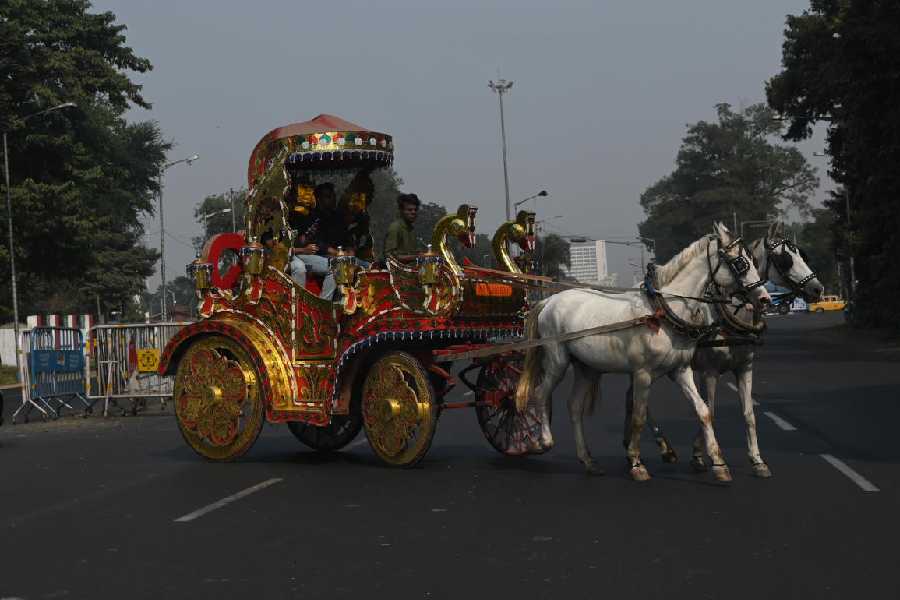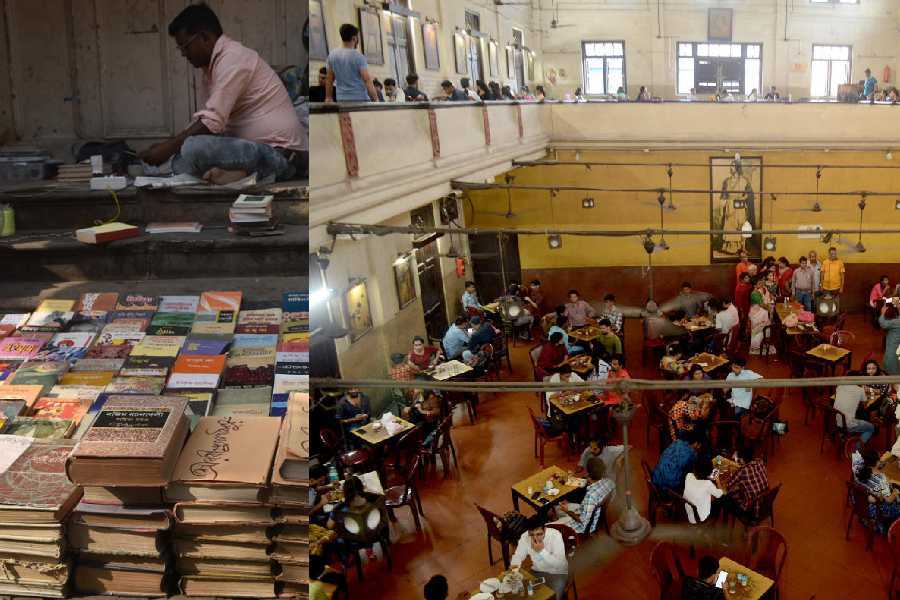There wasn’t a nook of the city that didn’t beckon me. The colonial architecture of the city, embodying Victorian, baroque, oriental, gothic and Rococo styles, transformed it into a city of palaces. One of my favourite haunts was the Victoria Memorial, completed in 1821. The beautiful white marble structure reminded me of the Taj Mahal. As a child, I was fascinated by the grandeur of its architecture and the richness of its museum exhibits devoted to the history of the British in India. Victoria Memorial was not just an attraction for lovers of colonial architecture and history, though. Dotted among the trees surrounding the monument and the enormous Maidan out front would be innumerable couples who would be much more drawn to each other than the magnificent setting in which they were courting. Fort William, built during the early years of British in India, was another one of my favourite spots. Even though the monument had been taken over by the Indian Army, a special permit was required to enter the place. One day, when I was loitering in the Maidan outside Fort William, I saw an army officer riding a stallion. Just as the rider was about to pass, summoning up all my courage, I asked whether he could take me in to look around. Smiling, he reined his mount and pulled me up behind him. To my great astonishment and delight, we then began slowly trotting towards Fort William. Once my short tour was over, as I was dismounting, I asked the great man his name.
“Sam. They call me Sam Manekshaw, young man.”

A horse-driven carriage close to Red Road Bishwarup Dutta
Besides the Victoria Memorial and Fort William, another Calcutta landmark imprinted in my memory is St Paul’s Cathedral, with its beautiful mosaics, murals and frescoes, and paintings of biblical scenes. Over 60-metre high, it is an imposing landmark. As with the Victoria Memorial and numerous other parks and gardens, the area around St Paul’s also used to be full of young lovers.
***
Calcutta is unimaginable without its clubs. One such club was the Tollygunge Club, which had, within its august environs, a golf course, horse riding facilities and residential accommodations. Only members and their guests were allowed in. Although neither my parents nor I were members, I managed to smuggle myself into the club on more than one occasion through the good offices of friends to sample its various attractions.
Another of my haunts was the Calcutta Race Course. My friends and I would pool our money and bet the “princely” sum on a jockey or a horse we liked the look of. We used to be quite ignorant of the horse’s lineage or the jockey’s track record, though. Conse- quently, I would lose my bets more often than not, and when my friends would mock me, I would say, “But I will be lucky in love.”
***
The Hooghly always captured my imagination, not just because of my granduncle’s exploit with which I began this book. Not only did the great river mesmerize me but its ghats also provided an endless carnival of delights. I would spend hours on Outram Ghat just watching the ceaseless bustle of activity: boatmen plying their trade, hawkers selling fast food, couples murmuring sweet nothings
to each other...

Boating - Hooghly River - Outram Ghat. Devi Prasad Sinha
...And then there was the food. Bengalis are obsessed with food. They are either eating or planning a future meal. A trip to the ghat was never complete without the joys of mouth-watering roadside food. All along the ghat, hawkers sold delicious fast food — phuchka, gol gappa or pani puri and jhal muri. How can one forget the mouth-watering aloo-dum and ghugni? As a result of my total immersion in the delights of Calcutta as a boy, Bengali remains my favourite cuisine to this day. If I were to choose one dish I relish above all, it would be sandesh or more properly shondesh.
The story of my life is incomplete without College Street — the street in central Calcutta, where D. Mehra made his first foray into bookselling. It stretches from Ganesh Chandra Avenue crossing in the Bowbazar area to Mahatma Gandhi Road crossing. The road north of M.G. Road continues as Bidhan Sarani (Cornwallis Street). College Street houses many centres of intellectual activity in the city. Well-known academic institutions such as Presidency University, Sanskrit College, the Medical College and Hospital, Kolkata, the Indian Institute of Social Welfare and Business Management, Hare School, Hindu School and the University of Calcutta are situated on the street. And then there was amaar adda — the Indian Coffee House, a cafe frequented by the city’s intellectuals for decades. Numerous bookstores dotted the area around the coffee house. It must have been a matter of great prestige for Indian Coffee House to host the brightest minds of the time, like Satyajit Ray, Manna Dey, Ashok Mitra, Taraknath Sen and other intellectuals and cultural icons, such as Amartya Sen, Mrinal Sen, Sukumar Choudhury and Aparna Sen. Other distinguished scholars, editors, artists, writers and cultural celebrities who formed its clientele included Ritwik Ghatak, Narayan Gangopadhyay, Sunil Gangopadhyay, Sanjib Chattopadhyay, Samaresh Majumdar, Subhas Mukhopadhyay, Shakti Chattopadhyay, Pritish Nandy, M.J. Akbar and Hiranmay Karlekar. In the late 1960s, the coffee house became one of the city’s centres of intellectual ferment when the founders of the Naxalite movement began frequenting it. Although the iconic poets Malay Roy Choudhury and Samir Roychoudhury, who were among the founders of the movement, were arrested and prosecuted, the movement they spearheaded ushered in new post-colonial thinking in academia and literature.
But the coffee house was not the domain of intellectuals and peaceful revolutionaries alone. Among its patrons were stalwarts of the Naxalite movement, such as Kanu Sanyal and Charu Mazumdar.
During the tenure of Congress Chief Minister (CM) Siddhartha Shankar Ray, the Calcutta police went after the Naxalites with a vengeance and the streets of the city were stained with blood. A whole lot of Naxalite leaders were killed. It’s an open secret that the then ruling Congress Party planted spies inside the unguarded Naxalite organization to gather information about its secret bases and arrest its supporters. Government intelligence personnel and police disguised as Naxalite sympathizers could easily infiltrate the party’s inner organization.
Many of its leaders were arrested, including Charu Mazumdar. The police had information about Mazumdar’s movements after he went underground in 1970, and he was finally arrested in Calcutta in July 1972. He died in jail days after his arrest, probably on the night of July 27 or 28. It is not known how he died, although the government reported that he died of a heart attack.
After the Naxalite movement was brutally put down, Jyoti Basu emerged as the state’s top leader and ushered in an era of peace that lasted for decades. I will not go into the politics of Bengal in any great detail, nor will I delve into the reasons why the Naxalite movement failed. However, one of my treasured memories as a youth is that of being in the presence of charismatic revolutionaries like Kanu Sanyal at the Indian Coffee House. From time to time, he would summon me and say: Ki rey, ekta packet cigarette niye aach (Hey, there, fetch me a packet of cigarettes).” I would do his bidding, heedless of his politics or what he was plotting. Such was the atmosphere of the Indian Coffee House in my youth.
There were other spots that I didn’t get to go to frequently but was intensely aware of — night clubs and restaurants like Trincas, Blue Fox and Moulin Rouge. Alas, neither had I any money to indulge myself in the epicurean pursuits offered by these nightclubs nor would the puritan Mehra household have approved of such escapades. No evocation of the Calcutta of the late 1960s would be complete without a mention of its football clubs (FCs), especially the epic rivalry between East Bengal and Mohun Bagan clubs.
Excerpted with permission from Rajen Mehra’s Never out of Print: The Rupa Story, published by Rupa










